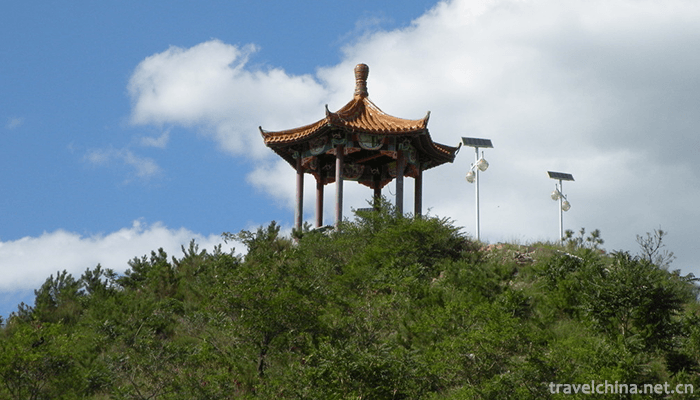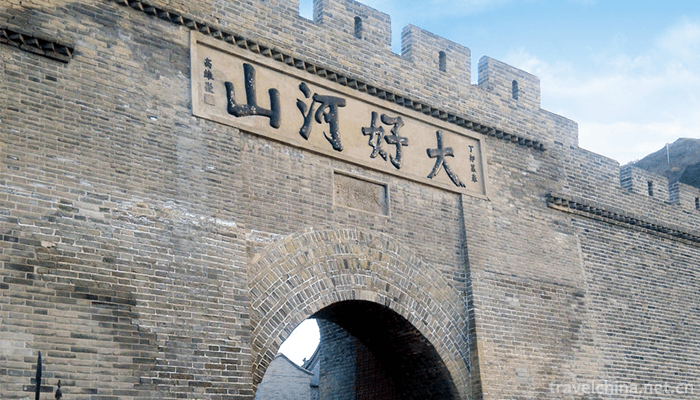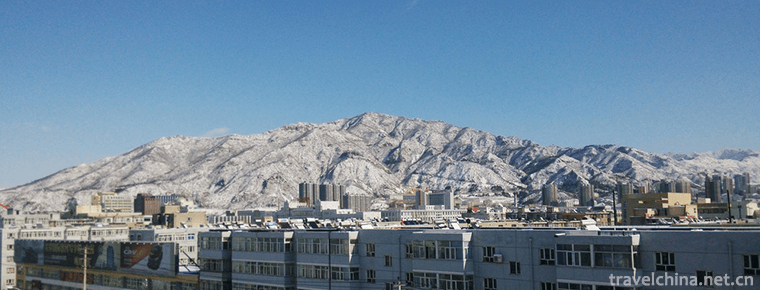Dajing gate
Dajing gate
Dajinmen, the national key cultural relics protection unit. Located at the northern end of Zhangjiakou City, it was built in the first year of Shunzhi in the Qing Dynasty (1644 A.D.) and has a history of more than 350 years. Dajimen is one of the four major crossings of the Great Wall of China, and it has played an important role in history.
Development history
The Great Wall of Zhangjiakou City was built in the 21st year of Chenghua Ming Dynasty (1485 A.D.). It is 450 kilometers long. The Great Wall in Qiaoxi is 3700 meters long. It is built along the mountain. It is made of stone and mortar. Outside the border, the East and West Taiping Mountains confront each other with a very dangerous terrain. Historically, this area has been an indispensable place for military strategists. It is the main road connecting the frontier fortress and the interior of Kyoto. At the same time, Dajinmen was also a place for friendly exchanges among Mongolian, Han, Hui and Tibetan cultures. In the Qing Dynasty (1644-1911), Dajinmen was a very important commercial city in the north, known as "Lulu Commercial Port" and "Pidu". Dajimen, as the northern gate of Kyoto from ancient times, connecting the frontier fortress and the mainland, has always been a place for military strategists to compete for. It is also the border of transportation and trade between the Mongolian and Han peoples. It has played an important role in developing the friendly relations between the Mongolian and Han peoples and in communicating the trade between the mainland and the frontier fortress. Due to the prosperity of Zhangjiakou's economy, the Qing government built the first practical railway in China, the Beijing-Zhangkou Railway, from Beijing to Zhangjiakou in 1909.
Dajimen is a very special gateway among the many passes of the Great Wall of China. Academic circles at home and abroad have been listed as important as Shanhaiguan, Juyongguan and Jiayuguan. The gateway of the Great Wall of China is called "Guan" and "Kou", but only Zhangjiakou is called "Jingmen", which contains the charm of "commercial culture" and "military culture", and also the historical origin of ethnic integration. From the five years of Longqing in Ming Dynasty, the border trade market known as "Gong Shi" and "Tea-horse Mutual Market" gradually formed in the area of Yuanbaoshan outside Zhangjiakou Dajimen. Livestock, fur, medicinal materials, woolen fabrics and silverware from Mongolian grasslands and the hinterland of Europe have been replaced here with silk, tea, porcelain and sugar. Outside the border, they have become the inland ports of international barter trade in northern China. The feudal dynasty was bounded by the Great Wall and the gate, and the foreigners who did business could only trade outside the city. "Border Gate" means the border gate. In 1927, Governor Chahar commanded Gao Weiyue to write on the lintel of the border gate the four big characters of "Dahaohe River and Mountain", vigorous and powerful, quite spectacular, adding charm to the border gate.
War and peace, life and death, prosperity and desolation, recur and change here. Dajimen has gone through many vicissitudes, which is the witness of Zhangjiakou's history. Many important historical events are closely related to Dajimen. Dajimen witnessed not only the weakness of the old China, but also the prosperity of the new China and the great changes in the history of Zhangjiakou. Zhangjiakou people are proud of Dajimen, which naturally becomes the symbol of Zhangjiakou.
Main attractions
The shape of the Great Wall Gate is simple and heavy, and its rough and vigorous, limited and unconstrained momentum is unique in the whole Great Wall culture, and it is the main road to Koubei. In order to protect cultural relics and historic sites, the municipal and district governments have begun to carry out comprehensive rehabilitation and comprehensive development of the Dajimen, making the area around the Dajimen a tourist attraction. The tourist summer resort is a brick arch with stone foundations. The gate wall is 12 meters high, the bottom is 13 meters long and the width is 9 meters. There are two wooden iron gates. The top is a platform, 12 meters long and 7.5 meters wide. Outside there is a 1.7-meter-high stack, inside there is a 0.8-meter-high parapet. There are four characters of "Dahao River and Mountain" written by the local military and political leaders in 1927. They are vigorous and spectacular. Legend has it that Emperor Kangxi of the Qing Dynasty returned to Kyoto on an expedition. He went there at night and slept outdoors. After that, Wolong Pavilion and General Pavilion were built.
Scenic spot
In 2010, it was upgraded to national 4A scenic spot, the Ming Great Wall of West Taiping Mountain, the Great Wall of Northern Wei Dynasty, Xiaojimen, Dajimen, Erlang Temple, Guandi Temple, Stone Carvings, Yongshun Gate of Laiyuan Fort, etc.
By 2012, Dajinmen and Zhangjiakou Fort (in the fort), Laiyuan Fort have declared national cultural relics as a whole, and a number of historically valuable cultural relics and buildings, such as Lecture Platform, Sanniangzi Temple, Guanyue (Guanyu and Yuefei) Temple, Mountain Temple and Shuiguan Temple, are also actively protected, renovated and developed. From 2010 to 2011, the first phase of the whole renovation plan will be completed, and the Great Wall of Dajinmen will initially restore its historical features. In the future, Dajimen Great Wall and Zhangjiakou Fort will become the ancient city of Heping Yao, Shanhaiguan and other well-known Chinese traditional Ming and Qing architectural complex, and become a beautiful landscape.
Practical information
Ticket information
20 yuan, free from the West Taiping Mountains.
Traffic information
External traffic
Airplanes, trains, cars, self-driving.
Self driving route
(1) Dajiemen has superior geographical location and convenient transportation. It connects Beijing and Tianjin in Nantong with Jinmeng in the north. National Highway 110 and 207 and Beijing-Baotou Railway pass through it. Xuanda, Danla, Beijing-Zhangzhou and Zhangcheng expressways meet here.
(2) Beijing-Badaling Expressway-Beijing-Zhangjiakou Expressway
From Beijing South Railway Station to Zhangjiakou Railway Station, change to city bus to Dajie
Internal traffic
There are 2, 13, 16, 32 and 301 buses leading to the Dajimen scenic spot, which is located in Zhenggou Street, Zhangjiakou City. The average bus departure time is 10 minutes or 20 minutes, and the fare is one yuan.






-
1.Free and unfettered hu hot soup
The authentic Xiaoyao Town Hu Hot Soup, produced in Xiaoyao Town, Xihua County, Zhoukou City, Henan Province, is a famous snack in China
Time 2018-11-26 -
2.Eight Immortals Crossing the Sea Scenic Area
Eight Immortals Crossing the Sea Scenic Area, also known as Eight Immortals Crossing the Sea and Eight Immortals Crossing the Haikou, is situated on the shore of the North Yellow Sea in Penglai City
Time 2018-12-23 -
3.Three Mausoleum of Shengjing
The three mausoleums outside Guanzhou refer to the Fuling Tombs of Nuerhachi, the Taizong Emperor of the Qing Dynasty, and the Zhaoling Tombs of the Taizong
Time 2019-02-08 -
4.Rice custom
Wannian rice custom and Shangrao Wannian County custom are cultural heritage. Wannian is the "land of rice". The traditional rice custom has been passed down in this area for thousands of ye
Time 2019-04-26 -
5.Leizhou song
According to the records in historical books, Leizhou songs were prevalent as early as the Song Dynasty. After the 1990s, people divided Leizhou dialect into different rhymes to express different cont
Time 2019-05-11 -
6.Lichuan lantern song
Lichuan Lantern Song is a traditional folk dance that originated in Baiyang area of Lichuan City. Many folk songs in Lichuan Lantern Song and the ancient bamboo branch song inherit in one continuous l
Time 2019-05-13 -
7.Sichuan Police College
Sichuan Police College is the only full-time undergraduate college of political, legal and public security in Sichuan Province, which is sponsored by the People's Government of Sichuan Province and jo
Time 2019-08-31 -
8.Cai Jing
Cai Jing (February 14, 1047 - August 11, 1126), character length, Northern Song Dynasty Prime Minister , calligrapher, Xinghua Army Xianyou County cixiao Li Chi Ling (Xianyou County, Putian City, Fuji
Time 2019-09-14 -
9.Tiantai Mountain in Qionglai
Tiantai Mountain Scenic Area in Qionglai is located in the southwest of Qionglai City, the hometown of Wenjun. It is the habitat of Sichuan Giant Panda. It is 110 km away from Chengdu City and 45 km away from Qionglai.
Time 2020-11-05 -
10.Geographical environment of Mianyang
Mianyang City is located in the northwest of Sichuan Basin, in the middle and upper reaches of Fujiang River, bordering Qingchuan county and Jiange County of Guangyuan City in the East, Shehong city and Daying County in Suining City in the south, Luojiang
Time 2020-12-14 -
11.Yibin scenic spot
South Sichuan Bamboo Sea is a national AAAA tourist attraction, covering an area of 120 square kilometers and a core scenic area of 44 square kilometers. There are eight main scenic areas, two major scenic spots and 134 scenic spots. In 2009, it was se
Time 2020-12-18 -
12.Social security in Guangan
As of 2019, there are 64000 urban and 217000 rural minimum living allowances in Guang'an City. The per capita subsidy level of urban and rural minimum living security will be increased by 27 yuan and 8 yuan respectively (according to household insura
Time 2020-12-19